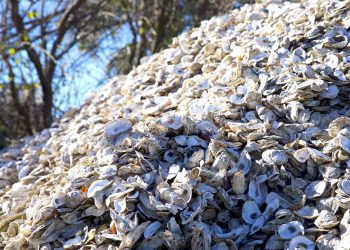Oysters and clams feed by filtering protozoa and marine algae from the water. They share many physical characteristics and conditions for good growth.
Due to their suitable shell structure, barnacles are abundantly parasitic on oysters and clams, especially in grasslands or marshy sands.
So how do oysters barnacles and clams feed? Is there any difference between them? I’ve done extensive research to clarify how barnacles digest food on oysters and clams in this article. Let’s explore it now for details!
What Are Oysters?
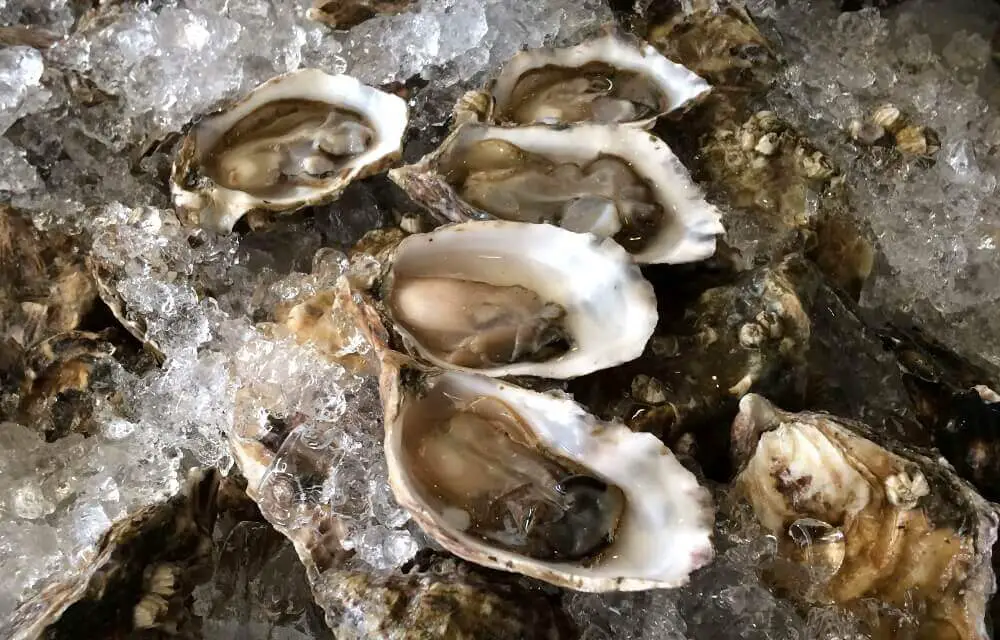

Oysters are bivalve mollusks found in many oceans around the world. They bring high economic value because of their nutrients and gems.
Shiny pearls are available as jewelry and decoration in many different cultures.
Its flesh is rich in nutrients with protein, glucose, fat, zinc, magnesium, and calcium. It can be available in various dishes with its characteristic greasy taste, which is good for your health.
Also, they play an important role in purifying polluted water. Many studies have shown that keeping oysters alive in the wild reduces water pollution and ecological imbalance.
Its size is relatively large compared to other clams in the same bivalve family.
The daily food of this marine animal is plankton. So, the ideal growth and habitat for it are in the estuary. This place has few waves, moderate salinity, clean water, and gentle currents to suit their lifestyle.
Read more:
What Are Clams?
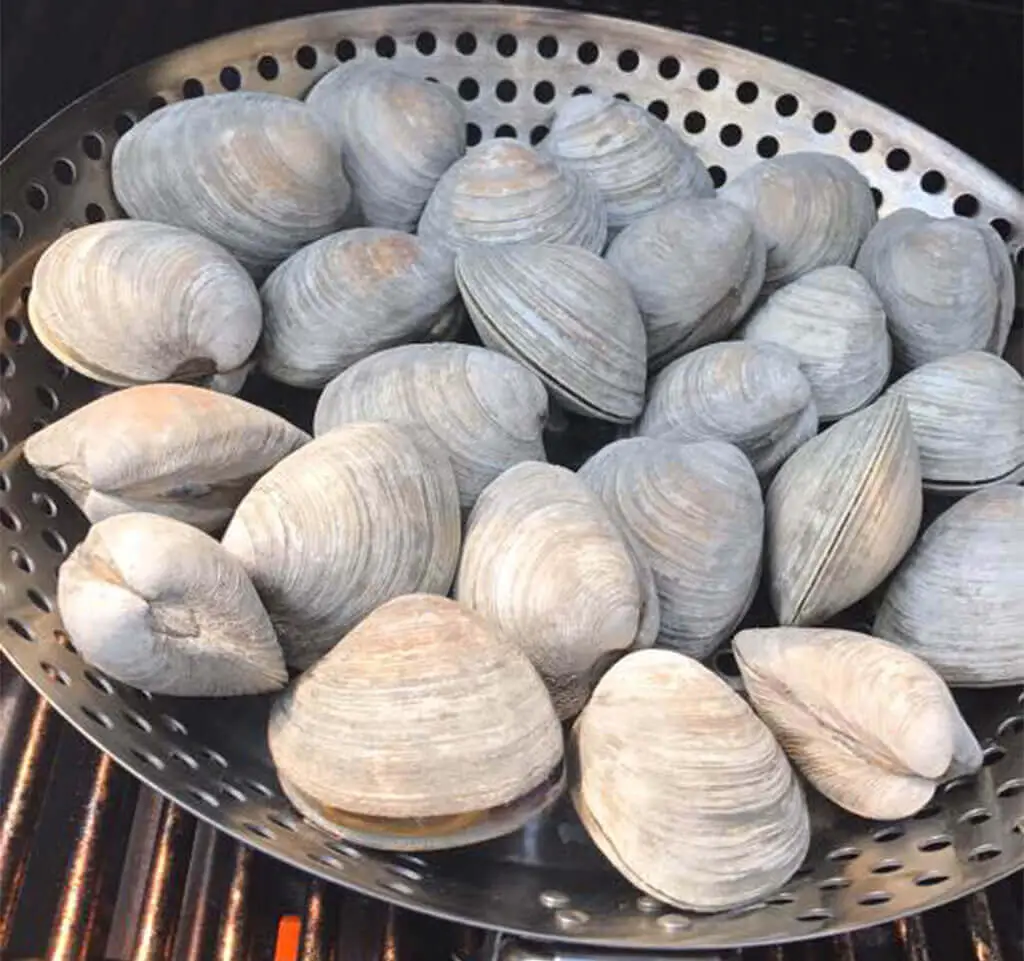

Clam is the name given to bivalve mollusks, which mainly live in high-saline coastal waters with sandy soil. They are common in tropical or subtropical seas.
For shape, clams have round bodies that are white or pale yellow.
They feed on various foods in the wild, including algae, phytoplankton, and other organic matter that accidentally passes through their filtration systems.
So how do they hunt? Clams use attractive methods to obtain and quickly consume the taken feed. By moving flexibly, it uses its cone muscles to better position itself in the water and starts hunting.
They do not self-associate with substrates like oysters. Instead, they will seek out areas with abundant food sources to advance to hunt.
For humans, clams are an attractive and nutritious food. It provides energy, protein, and organic calcium that are good for human health.
Clams can be available with different dishes to bring out the delicious and attractive taste.
What Are Barnacles?
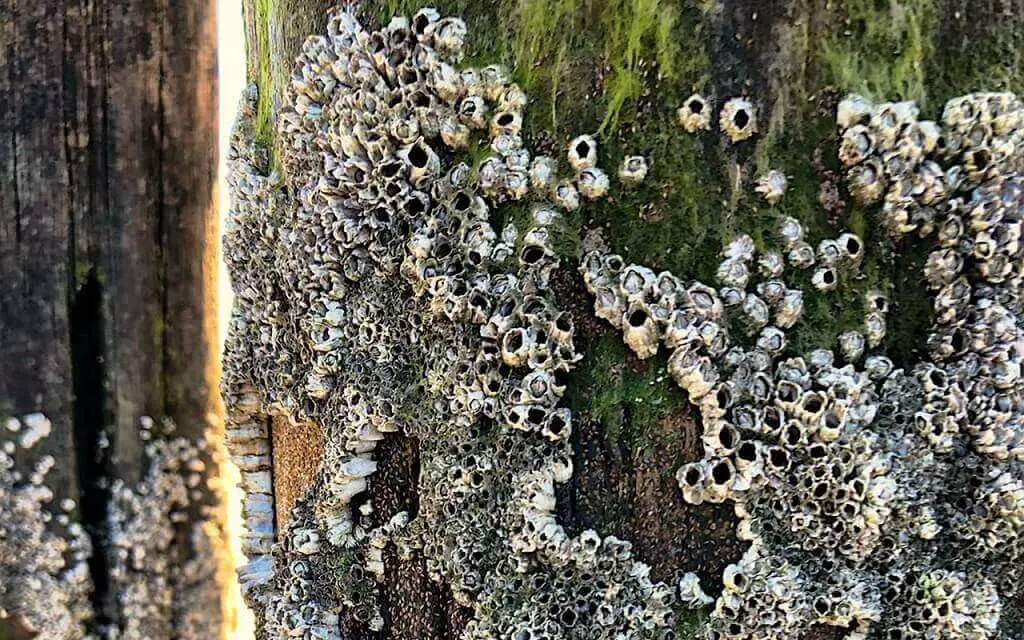

Barnacles are arthropods hidden deep within the crustacean sublayer, related to crabs, shrimp, and lobsters.
They are marine species particularly prone to living in shallow and tidal waters with corrosive environments.
Barnacles are not mobile because their food source is mainly in the suspension form. As crustaceans, they need to follow the correct life cycle to become the adult form we often see. It consists of 4 stages, including larva and adult:
- Nauplius
At this stage, the fertilized egg will become a one-eyed and one-headed nauplius larva without a chest or abdomen.
This process will have to go through up to 6 different molts before turning into cyprid larvae. With nauplius, the parents carefully incubate and release after the first molt as free-swimming larvae.
- Cyprid
It is the final larval form before adulthood. This phase usually lasts a few days to a few weeks for it to explore potential attachment surfaces.
Once it has found a suitable spot, it will attach its head. When the larva has exhausted its energy reserves, it becomes less selective for spawning sites. It will self-adhesive to the substrate, then undergo metamorphosis into a child’s body.
- Adult: This process marks the strong barnacle’s development. It forms six rigid calcium plates to surround and protect its bodies. They attach to the substrate for the rest of their lives and hunt with their feathers.
- Sexual reproduction: The final stage is sexual reproduction. It can self-fertilize but need heterosexual intercourse to fertilize and maintain the breed.
No matter what stage of growth, this protozoan can parasitize safer hosts such as clams and oysters. This evolution makes it easier to catch and digest food.
How Do Oysters Barnacles and Clams Feed?
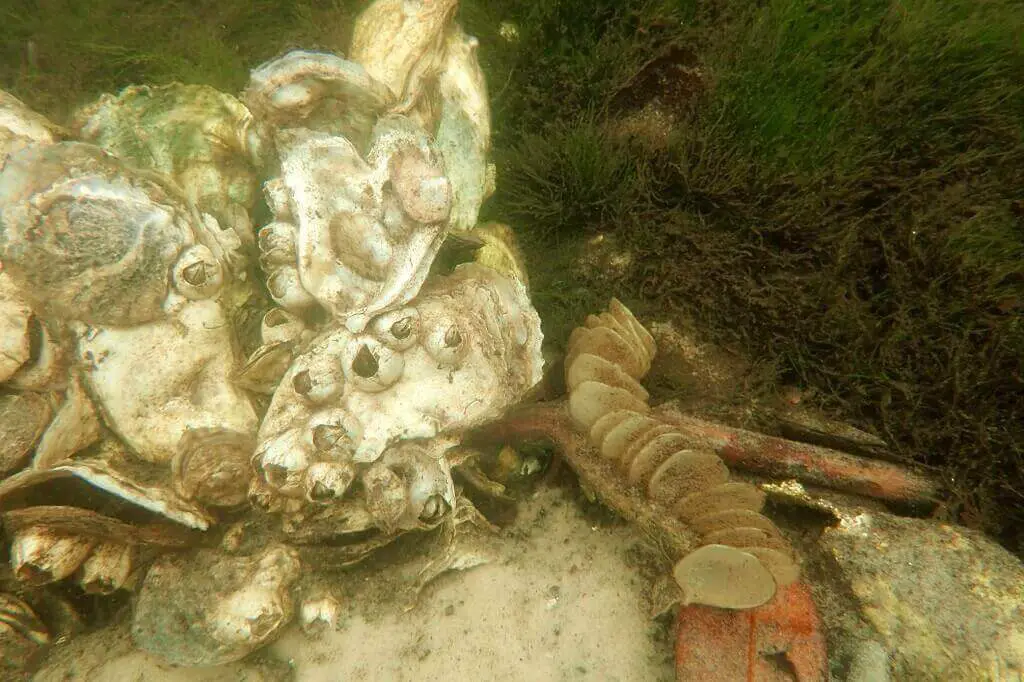

Since both are filter digesters, they only capture aquatic parasites such as protozoa and marine algae for growth.
Oysters Barnacles
The barnacles’ feeding is accomplished through feather-like appendages or cirri.
As the circle rapidly expands and retracts through the top opening of the barnacle, they suck out small creatures.
After hunting, they quickly retreat into their protective shell to avoid potential threats. Its outer shell is highly rigid and formed from many years of existence.
It is a white cone surrounded by six calcium plates secreted by barnacles. This evolution helps the bunch to gather food in a short time quickly.
Its mouth part has four strong calcium plates, flexible opening, and closing to serve foraging. The rising tide is the ideal environment for these doors to function, which closes to trap moisture and protect their bodies.
Barnacles On Clams
This species obtains food by filtering water through a feeding siphon into a breathing siphon.
The clam traps the passing food in a sticky mucus and then swallows them with its palate. In this way, marine life, such as algae or phytoplankton, will quickly break down the contents into nutrients.
After successfully bringing the food to the mouth, the nutrients will pass down the esophagus to the stomach.
Here, digestion and absorption take place. Finally, it pushes waste products into the terminal glands for further digestion.
They will promptly hide in their shells if they sense any danger. They soon retreat into their protective shell if they detect a potential threat.
Around this crustacean is a solid layer of white calcium, like a door that opens when the water is high. It will be a golden time for the feathered Cirri to catch as much food as possible.
Meanwhile, when the tide recedes, its calcium scales will close and stay dormant on the oyster’s surface.
What Are the Differences Between Oysters and Clams?
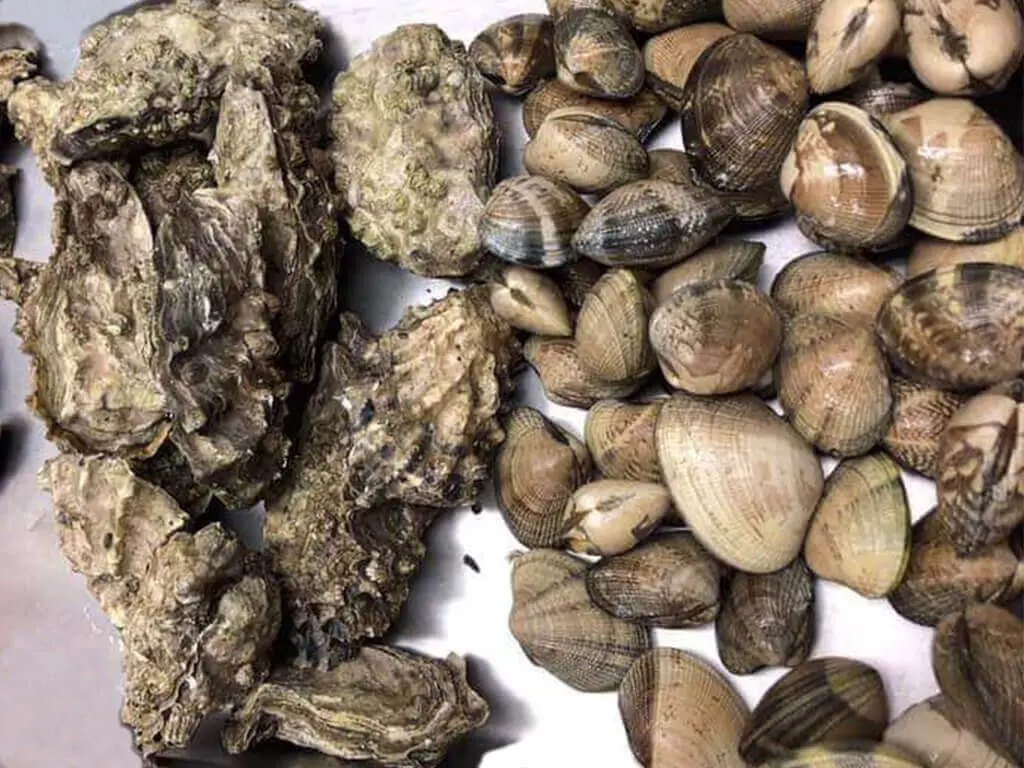

There are many differences between oysters and clams. The following section will help you distinguish the two with detailed comparisons.
Appearance
Through the outer shell, we can easily distinguish between oysters and clams.
The clamshell is often buried with an outer layer of fine sand, so it usually has a beautiful dark and light vein color. Meanwhile, oyster shells are rough and bumpy with wavy lines that are more pleasing to the eye.
The reason for this difference is their body structure, developed to help them adapt to the best living environment and grow.
Habitat
Clams can be found in a wider variety of habitats than oysters. Although both live in saline and brackish coastal waters, clams can also be found in most types of freshwater environments, especially in large rivers and streams.
Clams use their feet to lie buried in the mud and sand, from just beneath the surface to depths of roughly 11 inches.
Oysters generally prefer shallow saltwater areas, they need to parasitize rocks or other creatures on the ocean floor.
Flavor
The taste similarities between clams and oysters are immense if they live in the same freshwater or saltwater. When they are in different environments, the difference in taste will be more pronounced.
Cams will be chewy and have a saltier flavor than oysters. Meanwhile, oyster meat is softer, so you can suck it directly out of its shell. Also, the oyster flavor is more concentrated with a sweet, rich, almost butter-like taste.
Nutrition
Both clams and oysters are low in calories and fat. Their nutrients are protein, vitamin B12, calcium, zinc, and phosphorus, which are good for health.
Many experts have found vitamin C, selenium, manganese, and iron in clam meat. Meanwhile, oysters mainly contain more potassium, zinc, and phosphorus. The difference in nutrient content helps to explain in part their distinct taste.
Texture
The capping texture is somewhat different between the two.
The oyster shell contains more extensive calcium content and is rougher because of its harsher habitat. Meanwhile, the clamshell is much more shiny and hard.
But what about the meat inside?
Clams are a bit more supple, while the tender flesh of the oysters makes it available for you to eat raw.
However, this has a lot to do with the type. For example, Littleneck clams are softer and easier to eat than popular oyster strains.
Price
Raw oysters are usually two to three times more expensive than clams because of their difficulty and scarcity. However, for significantly less, you can still find small-sized oyster strains in many supermarkets.
Usage
Oysters and clams can be prepared in various ways or eaten raw. Based on this fact, only some people agree with using raw clams for their meals.
Meanwhile, instant raw oysters are very popular in seafood restaurants because of their richer nutrition and distinctive taste.
And it is also the most apparent difference we can see through their usage.
Besides, clams are also often present in soups, grilled dishes, and paellas. Grilled oysters are the most popular appetizer you may know.
| Oysters | Clams | |
| Appearance | Rough | Smooth shell |
| Habitat | Saline and brackish coastal waters | Both saltwater and freshwater |
| Flavor | Soft and sweet | More chewy and salty |
| Nutrition | Potassium, Zinc, and Phosphorus | Vitamin C, Selenium, Manganese, and Iron |
| Texture | More extensive calcium content and is rougher | More shiny and hard |
| Price | More expensive | Cheaper |
| Usage | Available to eat raw | Rarely eat raw |
FAQs
Both oysters and clam barnacles have simple food digestion. I based on their lifestyle, growth, and food sources to answer some questions below.
Let’s explore it now!
What Are Barnacles on Oysters?
Barnacles are bivalve mollusks. They are related to clams, shellfish, and snails on the coast, rocky shores, or estuaries. It usually clings to large rocks and reefs. Its primary food sources are nanoplankton and marine algae.
In many cases, barnacles parasitize hard shells such as oysters to optimize foraging and digestion.
Do Clams Eat Barnacles?
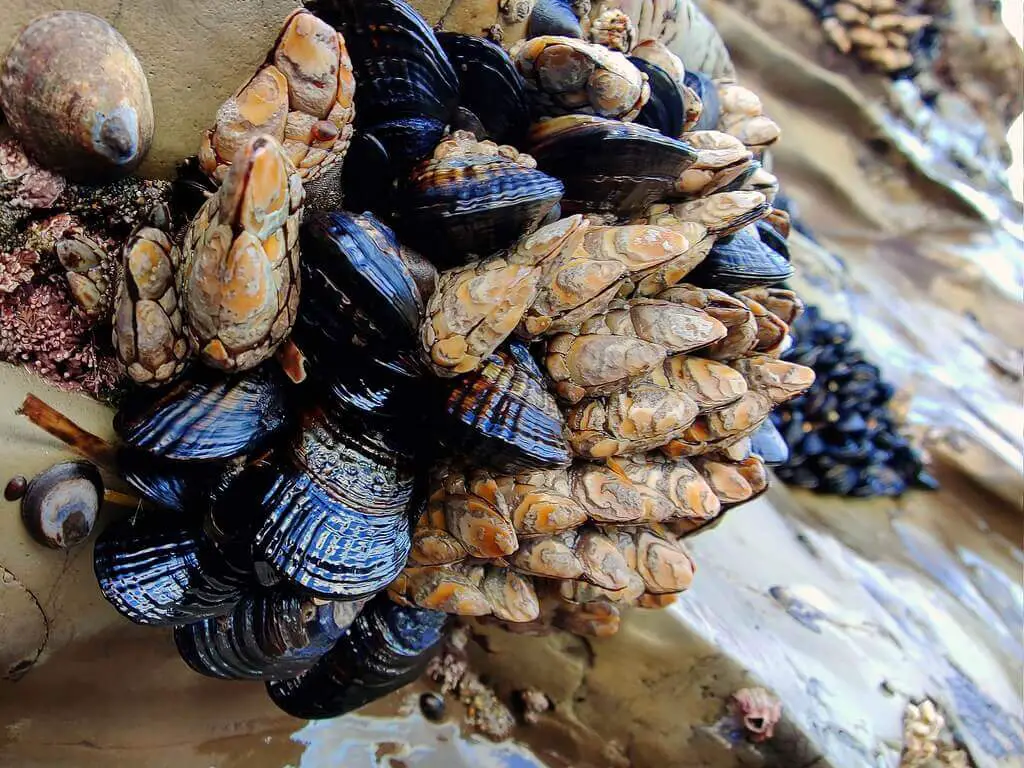

Yes. Clams easily eat barnacles because of their proper nutrition. Adult clams consume more because they need to grow and develop their species.
Why Do Barnacles Attach to Oysters?
Young oysters lying on the rocks will often have less vitality. And barnacles quickly attack the inside when the oyster shell is open. This young oyster will still function normally but slow down considerably.
What’s the Difference Between Barnacles and Oysters?
Barnacles are crustaceans, related to crabs, shrimp, and lobsters. They have a rough calcium outer shell, which protects the body from environmental harm.
Meanwhile, oysters are mollusks with bivalves. Its two pieces consist of two identical smooth halves to encase the entire body.
Can You Eat Oysters with Barnacles?
It is perfectly edible because the barnacles make the oyster taste more delicious and appealing. They are more memorable than ordinary oyster dishes. You can safely enjoy feeling its aroma better and fat safely!
Can You Eat Crab with Barnacles?
The answer is yes. You can eat if you’re willing. The barnacles on crabs usually have formed the outermost stratum corneum. Yet, it doesn’t matter if you just eat its insides.
According to experience from many fishermen, crab meat will be more delicious if it stays on the crab shell for a long time.
How Do Clams and Clams Reproduce?
To adapt quickly to environmental conditions, they both spray their eggs or sperm into the water and encounter gametes at random.
Do Barnacles Hurt Crabs?
It will be related to the category of barnacles. For example, most barnacles are safe with crabs, even when molting. However, some barnacles will stick to the crab for the rest of its life.
At this time, the toxins can penetrate the crabs through the parasitic osmotic membrane and can harm this organism.
Conclusion
The above article is the most detailed answer to the question: “How do oysters barnacles and clams feed?“
It will help you understand their living habits and growth characteristics.
Although parasitic on two different hosts, barnacles still live and digest food by the exact simple and effective mechanism.
If you have any further questions, leave a comment to receive a timely response from us. Thank you for reading!

